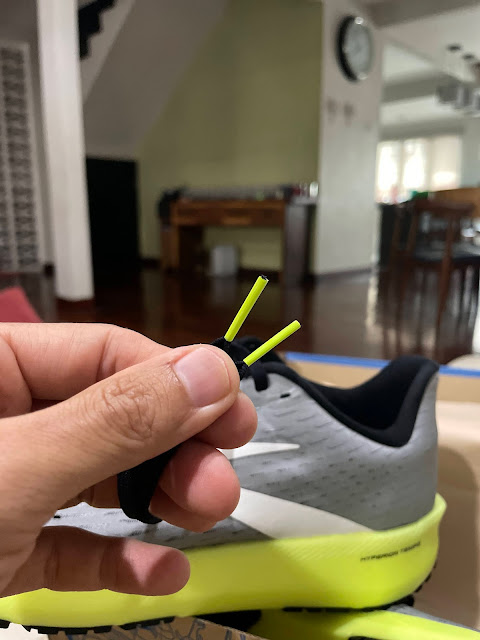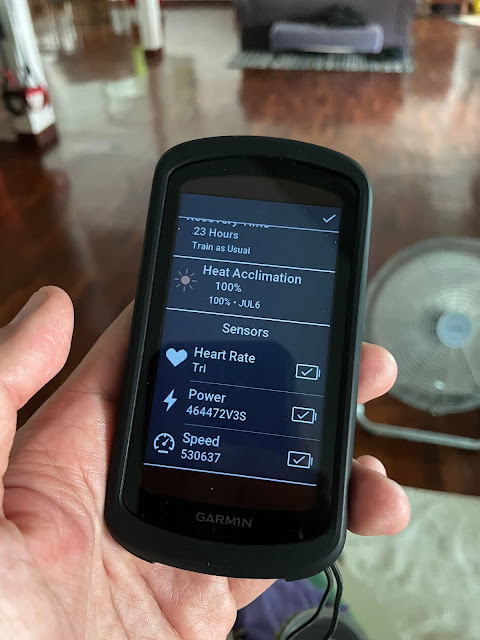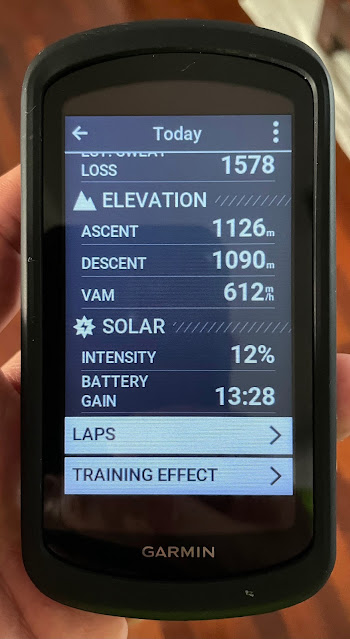The Hyperion Tempo has landed as part of my daily trainer. Here is a review of it.
 |
| Brooks Hyperion Tempo |
Brooks Hyperion Tempo. First launched in February 2020. I finally managed to get my hand on one from Sports Paragon (thank you!) being part of the ambassador. The "Hyperion" range is made for speed. Lightweight, fast and responsive. The Tempo is one level down from the Brooks supershoe with almost similar name - the Hyperion Elite 2 (and soon Elite 3 to be launched in Q3 of 2022). The biggest differences between these two Hyperion is the presence of full carbon plate and stack height. The Tempo is marked as a fast daily trainer, excellent energy return, cushioned and suitable for any distance up to a marathon.
 |
| Subtle Grey with bright yellow sole. Extrovert in an introvert world |
I have been trying to find reviews locally and I often get the feedback that the shoe is "ok". The Tempo is not widely reviewed in Malaysia, so a lot of reading were from overseas runner and missing the local (Malaysia or Asia) flavor. More likely as runners are more inclined towards supershoes (carbon plated) and some of these hidden treasure were left not reviewed and getting the attention it should. So here I am, 2 years 5 months after the shoe was launched and has put it through it's paces.
Unboxing
 |
| Hyperion Tempo is at the same level as Launch 8 - with differences being "super fast". |
 |
| US12 at 239grams |
I went one size up for the Tempo as it comes in one width (D or Normal). Based on the Ghost14 fitting, some space or up a size from US11 to US12 would give my toes some breathing space (and dead toenails). The Launch8 however was a nice US11 fit for me likely due to less structured upper. Weight wise, the Tempo is lighter than Launch8 (266grams US11) by at least 25grams. The official weight for Tempo US9 male is 207grams. The lightweighness of Tempo can be felt, figuratively speaking when compared to the Launch8. It is now officially the lightest shoe I ever had, ever.
Despite having Stryd pod on one feet, it is still lighter than my Launch8. That is how light it will appeal to gram-grannies. Infact, i believe the weight savings could had contributed from the thinner and lighter (but very stretchy) shoelaces as well. Kicking off with the laces, they are stretchable and flat. Brooks did not provide spare lace of a different color. Like Launch8, the Heel Lock lace hole is reinforced and in a better position than many shoes i have noticed. |
| Nice touch of yellow at the end of the super thin light lace |
Unlike the Launch8, Tempo comes with the Nitrogen-infused foam known as DNA Flash. This engineered foam is available full length on the Tempo. It is lightweight and adaptive to every stride. The DNA gel is adaptive to the force applied with the Flash putting in Nitrogen into the mix. A higher force will make it firmer. This meant the cushioning is able to adapt to be firmer when a heavier strides happen, and yet become more responsive with higher energy return when compared to Launch8. Infact, DNA Flash is presence in Hyperion Elite2 (and 3).
 |
| DNA Flash marking on the inner side of the sole |
The Tempo looked taller than the Launch8 due to the stack height. Coming in at 31-23 giving a 8mm drop vs the Launch8 of 26-16 giving a 10mm drop. The Elite2 and 3 is 35-27 (8mm) so it seems consistent from physical look itself. The extra was from the carbon plate and more DNA Flash around it for even higher energy return. |
| Totally unrelated, but still manifesting for the Hyperion Elite 3 Yes, that is MY HAND. I was that close, but not close enough to bring it home |
The upper of the Tempo is an engineered perforated mesh that has lend the lightweight profile and provided great support where it is needed. Despite the more volume midsole which obviously would had added weight, many would be surprised just how well the upper hold, with so little, again, figuratively speaking. As it's thin and perforated, the ventilation was very good and much better than Launch8 (which is already good) and of course much better than the reliable Ghost14.  |
| Lightweight upper that is also supportive and wrap the feet nicely while allowing for toe flex |
 |
| Side view. A shame that the white Brooks logo isn't reflective |
 |
| Heel cup that is well formed and supportive. |
The heel cup reminds me of Launch8. It is upward turned and locks in the heel really well. I did not have any heel slip in any of the pace I did. It hugs well and supported the feet over the terrains.
 |
| Carbon black outsole midfoot to toe, and at the heel section |
The outsole is presence at the front midsole to toe, and at the heel section. It is not 100% coverage which likely lend to the weight saving as well. Made of harder carbon black material. One concern I had was how much mileage I can get out of these. Looking at it and comparing it against the Launch8, i am convinced the Tempo can hold on to about 1000km or at least 5 months of exclusive use without any other shoes rotating. The outsole is generously thick, which will help with the wear rate. However, if you are a heavy heel striker, just keep checking the wear rate at the heel and replace (the shoe) as needed.
 |
| Closer look of the outsole near the toe |
 |
| Heel section |
 |
| outsole starts somewhere mid-foot |
The liner is a bit of a miss for me. I would had hoped the liner is made also from the same DNA Flash. It's basic and not as fancy as the Launch8 liner.
 |
| Basic (read: light) |
 |
| Even more basic when compared to Launch8 |
 |
| Launch8 liner which is same EVA foam as the DNA BioMoGo foam |
Similar to Launch8, the tongue is not gusseted or in layman term, not secured at all sides. It is a floater. Some see this as minus point, some is ok with it. Pros of a gusseted tongue is that it doesn't move and it prevent any possible grit or small stones from entering the shoe from the top of your feet (the heel/ankle area not withstanding). However, the secure point at the tongue convince me that it will not move under running motion.
 |
| Tongue not gusseted and lightly padded in the mid-section. Take note that there is a toe-reinforcement |
Also, similar to the Launch8, the toe section is reinforced to protect the toe and also to keep the structure and support. The inner of the shoe is smooth which allows the skin to be closer to the upper material, and thus, allow for better ventilation and cooling.  |
| Smooth inner |
I noted that the size label is not stuck or sewn to the side or tongue. It is like those tags on t-shirts and I actually cut them off as I do not want this material to potentially rub against my feet and causes friction.  |
| Cut and remove. Personal preference since it's not stuck down. |
First Feel
The lacing was a bit tricky due to two things - this shoe is a size bigger than my usual and the lace is stretchable. It took me a bit longer to find the sweet spot and once it was done, it secured my feet very nicely. I have normal arch and a mid-to-heel over pronation. First thing that hit me was that the Tempo doesn't felt "tall". It's amazing how 2mm differences (vs Launch8 10mm) felt. Bear in mind that Tempo has higher stack. As for feeling the DNA Flash for the first time, it felt... grounded. I meant, there isn't any "bounce" as the brain was already wired that the midsole is "nitrogen" infused.
 |
| Sleep and Run, they say |
The Medium width (D) felt great on my feet. My toes can splay out comfortably without having the small toes pressing out the side. Expected due to 1-size up. I believe this will be my size moving forward - and hope Sports Paragon will bring in larger size of Elite 3 because I really want to experience that.
 |
| Ample space for my Stryd too! |
...and First Run
Those that follows me will know I run similar route all the time. For this run, a 5km distance with elevation was chosen as I want to know/get to feel the energy return. The Tempo on first push off doesn't felt inspiring - it felt similar like my Launch8. So before you play this down, bear in mind that Launch8 was lively; so having the Tempo feeling similar is a good thing. This is to calibrate my own expectation and also for you dearest readers reading this review.
 |
| See the scuff mark on the yellow part in the front? Yeap, that's me hitting some barrier as I ran... haha |
The Tempo came alive and showed it's potential about 1km into the run. I know what is my pace/distance/timing/effort like every km as I run the same route every time.  |
| Same route, every time |
The DNA Flash started to show what it was capable of. I was running at a lesser effort every kilometers and noticed that the faster section (read: downslope) were much faster at the same feet turnover (cadence). Completing the 5km, I was pleasantly surprised of the data that was reported. |
| statistic and data doesn't lie |
Run 201/365 was 5 days ago using Launch8 and Run 206/365 was on Tempo. Both runs are in the same direction, same loop. Elevation gain per loop is similar. Even the weather was similar as with the timing of the day when the run was performed.  |
| Run 206/365 Leg Spring Stiffness |
 |
| Run 201/365 Leg Spring Stiffness |
The run with Tempo showed:
- Very similar feel to Launch8. A good alternative to a lighter shoe for rotation and for race if Carbon is not your cup of tea (as they also wear off faster).
- Almost similar pace when pushed. Test showed a 5s gap of 4:33 vs 4:38. Delta due to me stopping to take a video of my run which obviously impacted the overall average.
- 7W less energy on Tempo
- 7bpm less HR effort on Tempo
- Leg Spring Stiffness (LSS) numbers is slightly higher on Tempo vs Launch8 (ignoring the first km as I stopped to take video). This is a good indication of the "spring" the shoe provided. Need to test more.
 |
| Overall a good ride |
- light and flexible. Lightest I've worn.
- You feel grounded, yet you know the shoe will provide adequate cushioning with the DNA Flash.
- Fit is nice. Just need to find the sweet spot with the lacing pressure
- No noticeable hot spot in short run, for now.
- No heel slips despite drenched in sweat
- Very secure road-grip feel. No indication of slippage under faster pace.
 |
| First drench of sweat |
Cons- Concern of mid-section and heel wearing off faster than it should due to running gait.
To Test More
- Longer run
- Faster paced run
- 5k TT
 |
| In Service Now! |
This pair of Brooks Hyperion Tempo is courtesy of Brooks Malaysia and Sports Paragon. Retail price of this is MYR650, which put it in the mid-high range of daily trainers that is lightweight and offer performance enhancement vs regular heavier trainers. Be reminded that there is no carbon plate in this pair, but it can hold it's pace when compared to the other manufacturer's equivalent using carbon dioxide infused foams. This Tempo will sits nicely between your daily easy trainer (cushioned) and can be standalone for your go-to speed shoe on rotation.
Discount??? You Want Cheap?
As part of my sponsorship with Paragon Vests under the Team Sports Paragon, I have a few discount codes you can use to purchase your next Brooks shoes if you want. Older models at higher discount is available in www.sportsparagon.com website. Sizing can be a challenge, which explained the better discount. If you want newer and better sizing, head over to www.brooksrunning.com.my and score a few newer models.
I have the
full discount codes and brands that support me in 2022. But if you are lazy to click, here they are...
Promo Code: SPEV02
Footwear: 55%
Apparels: 50%
Sandals: 40%
Accessories: 50%
Promo Code: EEVANOFF25
25% OFF of all items ( exclude sale items )
Promo Code: ZOOTEEVAN20
20% OFF Zoot website Non promo items
10% OFF Zoot website Promotion items






































































